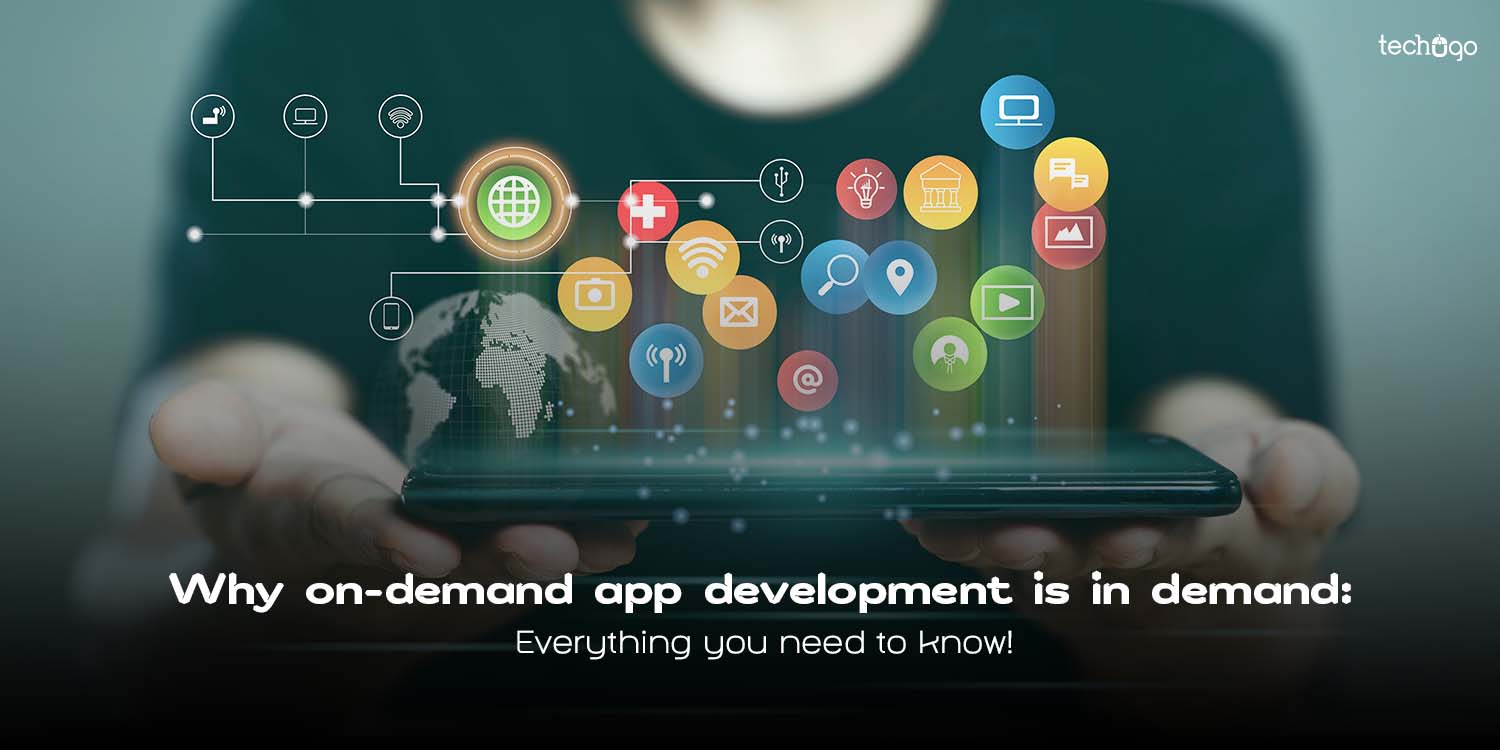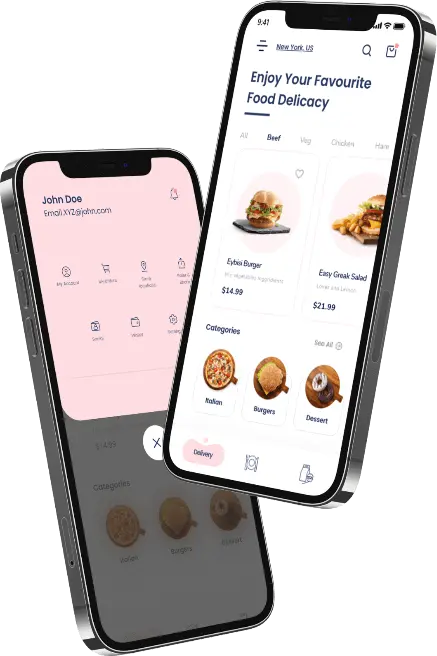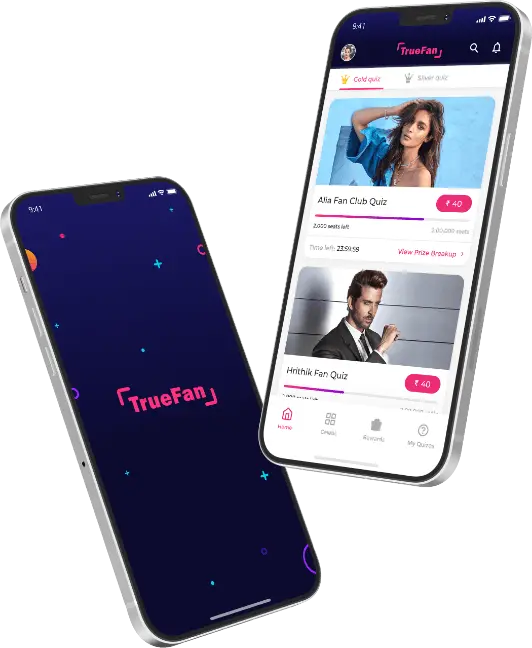20 Dec 2022
Why on-demand app development is in demand: Everything you need to know!
Surbhi Bhatia

Uber, Airbnb, and Uber Eats – On-demand apps have a significant share of our mobile devices. The digital age is here, and almost all products and services are available online. The rise in mobile users is even more remarkable, with 2.5 billion people using smartphones in 2016, and 3.5 billion by 2020.
Businesses need new ways to reach customers in this internet-centric and mobile-focused environment. The ideal solution is to use on-demand service apps. These apps enable you to offer on-demand services to large customer bases without having to meet them face-to-face.
What’s the deal with these on-demand apps, you ask? Can they bring value to your company? Let’s see.
What is An On-Demand App?
On-demand applications are web or mobile apps that allow customers to place orders for real-time services, such as food delivery and appointment scheduling. A marketplace is a platform that allows businesses to post their products. It could also be a dedicated application that a business creates to increase revenue and stay in line with the on-demand economy.
These models are very popular in the on-demand goods and services market. However, if your business already has a specific application you might want to consider developing a dedicated app. So you can determine whether this is a good idea for your business, we’ll explain the advantages of developing an on-demand app for a particular business and its customers.
Also Read – Cost to develop an on-demand app
An Increase in Demand for On-Demand Applications
On-demand services are booming. Why are people switching to on-demand services over traditional services? Let’s look at some of the reasons.
1. A Variety of Products
Customers face the greatest challenge when shopping at a retail outlet. The limited selection of products is what they have to choose from. Customers are forced to pick from the available products in the shop. Furthermore, they can search for multiple providers in their area or country using on-demand apps and choose what they want.
2. Reasonable Prices
Customers are always looking for discounts and lower prices. They can compare prices from different providers in their local area using on-demand apps. This transparency allows customers to choose the provider that offers the best value.
3. Convenience
Before Uber, you had to wait at a taxi stand to get a taxi. You can now simply open the app and enter your location. The taxi will then arrive at your door. Uber Eats is the same. There’s no need to wait in line at a restaurant for your order. Instead, you can place an order on the app to get hot, fresh food delivered right to your door. On-demand apps are highly in demand because of their convenience.
4. No Time Restrictions
Many on-demand services can be accessed 24/7. For example, Amazon allows you to place orders at any hour of the day if you wish to buy a laptop. Likewise, you can access the services of an app on-demand, regardless of whether it is 3 AM or 11 PM.
On-demand App Models
On-demand services apps are often developed using one of these three business models.
1. Business to Consumer (B2C)
Your on-demand app users are the end-users in the B2C model. These apps allow you to facilitate the sale of goods and services directly with customers.
Starbucks is one example. Starbucks’ app lets users skip the line and pay in advance to have their coffee delivered right to their door. Dominos, Uber and Booking.com are other B2C apps that can be ordered on demand.
2. Business-to-Business (B2B)
To connect businesses, B2B apps available on demand are created. These apps often have more features and are more powerful. They also support global transactions.
Eventio, for example, is a B2B platform that allows individuals and businesses to search venues for all levels of events. You can pick your favorite venue by selecting from security, catering, and other options.
You can further divide B2B apps into:
- Vertical – Serving one sector or industry
- Horizontal: Serving many industries or sectors
3. Consumer to Customer (C2C)
These apps enable users to exchange products and services. BlaBlaCar, Etsy and eBay are some of the most popular C2C apps. C2C platforms include Fiverr and Upwork, which are freelancing platforms.
On-demand app development costs will also depend on your business model. Before you invest in on-demand app design, make sure you understand your business model.
What Types of Businesses Require an On-Demand App?
Many businesses are able to benefit from on-demand services and goods. Here are some examples of services that make on-demand mobile app development logical.
1. Housekeeping Services
On request, a maid, janitor or entire cleaning crew can be arranged. This is especially useful when someone has to clean their office or home immediately.
2. Salon services
Customers can now book appointments online and find their nearest salons with the beauty on-demand app.
3. Hospitality services
This industry offers a great example of an on-demand services: On-demand food delivery, retail, and whatnot. Undoubtedly, Big data is driving retail innovation.
4. Retail on demand
This allows customers to make spontaneous purchases. For many merchants, this is a great way to increase sales. Apps make it easy for your business to be found online.
5. Pharmacy Services
We have previously written about the advantages and potential of creating a pharmacy application. This article will explain how the on-demand approach works in the pharmaceutical industry.
6. Telemedicine
On-demand services are mainly provided by scheduling apps for doctor appointments or remote consultation applications.
7. Repair and fuel
These services are a good fit for the on-demand model because car breakdowns can happen suddenly and often require fuel or repair to get them back on their way.
8. Dry cleaning and laundry
Consumers today want to be able to book a wide range of daily needs quickly and have them delivered promptly. This is possible with the help of on-demand laundry and drycleaning services, and mobile apps for car washing.
Benefits from On-Demand Service Apps Design to Businesses
A mobile app development service available on demand offers many benefits for businesses. Let’s take a look at each one.
1. Flexibility and Dynamic
Every day at work can be chaotic and stressful for a businessman. An app can help you simplify paperwork, payment clearances, and other details.
Let’s take, for example, a restaurant. During peak hours, orders continue to pour in. In such a rush, the manager will not have the time to enter the orders, make the invoices, calculate inventory, or create a requirements list.
2. The On-Demand Service Apps are Cost-Effective in Nature
It’s not difficult to see that building a fully functional app can be costly in terms of time and money. Building an app on demand that meets the primary user’s needs is cheaper and better.
3. There is clear scope for future scalability
Are you aware of a great idea?
Start by launching an app for on-demand delivery that meets the basic needs of customers. Then, you can expand the features of the app to make it an online marketplace where other businesses can register. In addition, the service fee you pay can increase your income source.
4. Super Secure On-Demand Apps
These consumer details include their name, address, favorite services, and price filters. All of these are collectively known as data. The app developer can create and manage a private cloud because the company is the owner of the app. This will keep all information safe and secure.
5. Potential growth
Apps are a way for businesses to grow in the digitalized age.
Are you not in agreement?
We know that you do!
On-demand apps allow the business concept and services to reach more people. A conversion rate of 30% is a common expectation, which helps with the business’ growth.
6. Allows Users (Consumers) to Leave Feedback
Negative feedback is very rude and boring for customers. Online apps come to your rescue.
Online platforms allow users to anonymously give feedback. These apps help service providers to understand their strengths and weaknesses without harboring grudges against consumers who are able to hide their identities.
ON-DEMAND APP BENEFITS TO USERS
Not only is it beneficial for the company, but also its customers. Your on-demand delivery app can be an excellent way for you to attract new customers looking for services right away.
1. Simple ordering
On-demand apps allow users to quickly find the service they need and then place orders in just a few clicks. This app is more efficient than phone calls and personal visits.
2. Tracking of the delivery status in real-time
Users can track the exact location of the courier who delivered their order using an integrated, constantly updated map. This feature is essential for any app that delivers food on demand. Additionally, it helps users plan their time.
3. One-click cancellation
Customers can cancel orders and reschedule appointments if something unexpected happens in an app like the doctor-on-demand apps.
4. Expanded payment options
Buyers can pay cash, debit or credit cards when they meet with the company in person. In addition, any on-demand apps can be integrated with modern payment methods like mobile wallets or cryptocurrencies.
5. Push notifications
Customers can choose to receive push notifications, so they are kept informed about their orders and any new offers.
How do you classify the most important features of custom-made on-demand apps?
Before you can plan an app, it is important to identify your target audience and identify a problem. On-demand apps are most popular with college students, millennials, and wealthy kids. It is important to identify their needs and find solutions through apps.
Every app that is available on-demand is the solution to the problem of hundreds of thousands of users. For example, consider lazy teens who hate eating out. It is possible to create an app that allows them to place orders online and receive delivery.
The on-demand app solution is classified into three parts. One is the customer side, two are the service provider side, and three are the admin side. These parts work together to achieve the best outcome. Below is a list of the basic features of each part.
Customer App
Registration – A customer-side, on-demand app allows easy registration via a social media account or email. The phone number-based registration option (OTP), is an excellent choice for private transportation and related apps.
Tracking in Real Time – This is one of the most valuable features of the on-demand app. The app allows users to track their orders and determine the delivery time.
This feature improves the reliability of your on-demand services. In addition, app users will find it useful for keeping track of the status and services they have ordered.
Push Notification- Without this feature, it is hard to imagine an app that can be used on demand. Push notifications can be used to spread awareness about new services and promotional offers. But, it is important to determine the right strategy.
Also Read – Get Your Customers Back to Action with These Push Notification Trends
The on-demand app offers integrated payment gateways- Swift online payments and secure payment. To make it easy for app users to pay across multiple payment channels, the on-demand app developer integrates the payment gateway into your app.
Pay with your app using credit/debit cards or netbanking. Multiple payment options make it easy for customers to pay and ensure that the whole process is reliable.
Help Centre – App users and customers can ask questions or contact the company regarding app or service issues. The company will respond to the users’ questions and resolve any issues quickly. This feature allows the company to provide prompt responses to customer queries and improve its customer service.
Ratings and Reviews- From the customer’s perspective, the feedback of the user is very important. This allows your customers to share their experiences, and you can also get valuable feedback. In addition, these reviews can help your business get found by search engines.
Delivery app
Request rejection or acceptance- Service providers such as drivers, delivery men, and so on. These features allow you to accept or reject your request. For example, they can reject the request if they feel they cannot complete it within the given time or accept another one.
Log- This log includes the beginning and ending points of the service. It is important to calculate how much they make by offering the service. This feature allows them to manually start or stop the service. All completed requests are also recorded.
Track Earnings – This feature is essential for delivery persons’ apps. This feature allows delivery people or service providers to track their earnings. This feature allows them to track their earnings on a daily basis, weekly basis, and monthly basis.
Service providers can be motivated by tracking earnings and plan their day more efficiently. This can also translate into greater productivity, which will be a benefit to your company.
Scheduling- Service providers require flexibility. This allows them to create a work schedule, and they can then complete their tasks as required. Although this is not a mandatory feature, it can help the service business by providing more accuracy and allowing providers to complete their tasks on time.
The availability- This feature allows service providers to choose their availability. They can select the time that is most convenient for them to process their request. This feature allows them to choose the time they will appear online. The app users can choose another service provider if they are offline.
Administration Panel
This section is the most complicated and robust. This section contains all the functionality of the on-demand app. This section allows you to control all operations. The admin app contains important and essential features. Let’s take a look at a few of these important features.
Dashboard – Any on-demand app needs an interactive, customizable dashboard. Administrators can easily navigate through different sections of the dashboard to monitor all activity.
The admin dashboard provides a single point of control for all on-demand services. The admin dashboard is a single-point control for all on-demand services, whether it’s user management or provider management. Our app developers are skilled in building robust dashboards with an easy-to-use interface for the app.
Algorithm – What is the best way to match a service provider and a customer’s new request? It is difficult to match every service request with the right service provider manually if there are many. Therefore, an algorithm has been developed to allow for automatic matching.
Analytics- You need to know the results of your app-based services, and the number of people who use them. Analytics can help you do this. The analytics provides real-time information on different sections of your company, so you can identify the weaker areas.
Service Request- The user management feature is able to take care of all aspects of your order, from cancellation to payment receipt to the completion of an order. This feature allows the admin to quickly resolve any questions.
5 steps to On-Demand App Creation
On-demand app development, as mentioned above, involves the creation of multiple applications.
- A mobile solution for customers
- A mobile product for providers
- Administrators can access a web portal
What are the steps to create your own app for on-demand services?
1. Rapid Prototyping
Techugo begins on-demand mobile app design by building a prototype. This is just like any other mobile solution. What is a rapid prototype? This is a visual representation of your product with no code underneath. As a first step, create an on-demand service application.
To verify your idea, we start with a prototype and then fine-tune it to meet your customers’ needs. Users can view the prototypes in their browsers or on their mobile phones.
You can improve the UX based on their experiences with the prototype. It is also possible to improve the UX without writing code. This keeps your development budget in check.
2. Development
Filling the graphical app shell is the second step to building an on-demand platform for service. Your software engineers should be familiar with this process. These are some things to remember.
BACKENDS
Are you ready for the second eureka moment? You will not only need to create three applications for on-demand services, but you will also need to develop backends.
As you may recall, the back end is where most logic and calculations take place while customers interact with the front ends (mobile or web applications).
You will require at least one back-end for provider and end-user applications and one for the admin web portal. The back end is your app’s brain. APIs allow all applications to communicate with each other and share data.
APIs allow your mobile product to connect with other software. You should consider whether your product is likely to benefit from the creation of new products by other developers.
CODE REUSABILITY
You don’t need to create both mobile apps from scratch. To speed up development, you can reuse some code blocks. This is true for all components similar to each other, such as registration and authentication, user profile, and settings.
Also Read – How Much Does It Cost to Develop a Mobile App?
MAKE USE OF MOBILE SDKS
Mobile SDKs are another way to optimize your budget while creating your own on-demand application. You can quickly develop different features for your on-demand app using a variety of pre-made SDKs.
OFFLINE MODE
You might consider adding offline app support. This feature is a complex one, but it’s worth the effort. Your engineers need to create a caching mechanism that synchronizes all input data even if the app is offline. Clear visual clues will be required for both offline and online modes.
MACHINE LEARNING
On-demand apps are becoming increasingly popular because they are often very intelligent. They get to know users better and can fine-tune matching and recommendation algorithms.
PAYMENTS INTEGRATION
It is difficult to build a digital wallet within an on-demand app. Integrating with Stripe, a payment processor company, is a better way to add payments to your app in its early stages. Uber, for example, used Braintree to manage their payments in the past.
As you accumulate sufficient transactions, you will be able to integrate with banks and MasterCard/Visa later.
Apple allows you to promote other payment methods at the same time as this article. When you are ready to offer subscription services, you will be able to sign up new customers without paying Apple’s fee.
3. Quality Assurances AND DEVOPS
You must make sure that your on-demand app performs well before you release it.
AUTOMATED TEST
Manual testing is a nightmare when you are developing an on-demand app. To automate testing complex solutions like an on-demand app, you need to use QA platforms such as Sentry. Automated testing helps you detect issues and guide your coders to the correct solution.
Kobiton, a specialized product that allows you to accelerate mobile testing, is another way. You can test your mobile apps on demand on different OS versions. This is a huge advantage. Imagine a robot army with thousands of smartphones and your app.
Manual testing
Manual testing is not impossible. Automated tests can quickly identify many issues. Your QA team will then process the apps manually to catch any remaining UX issues and minor glitches.
Make sure that your team runs all the tests necessary to ensure your mobile apps and admin portal are working properly.
- Regression
- Unit tests
- Integration tests
- Smoke tests
- Functional
4. Release
Finally, you will have a working web and mobile software that is gold. This is when you will release it.
This may seem like an easy step. It takes just a few days to get the apps on the market. However, this is only true if your development team has a lot of experience and understands all the requirements for Google Play and App Store.
Upload the mobile apps to the appropriate mobile stores. Make sure that they communicate with the production environment on the server side.
Side note: During development, applications frequently exchange data with a test server environment.
5. Maintenance
You probably know that once an app is successful, you cannot rest easy. Therefore, you should be ready to monitor app performance and process user feedback in order to plan for future updates.
Users can still report bugs and edge-case situations on strange devices. If you have followed our advice and set up an application performance tool, then you should be fine.These accidents can be quickly identified and fixed.
Google Analytics, a tool that collects data about how users interact with an application, can be used to provide further insight. Sometimes, it can lead to UX improvements. Let’s suppose that most users skip the initial-launch tutorial. You need to find a better method to onboard them.
Google Analytics for mobile apps is the same as Google Analytics for websites. You can create better funnels by reviewing app usage data and optimizing the UX of the application.
To Sum Up!
On-demands are expected to grow in popularity due to the constant rise in mobile users and their reliance on the internet. As a result, businesses that resist the shift will soon lose customers and move to digital solutions.
No matter what type of business you have, an on-demand application can help you engage customers better, improve customer experience and increase revenue.
For further information on the concept, book your consultation today!
Have fun with innovation
Get in touch.
Write Us
sales@techugo.comOr fill this form



 SA
SA  KW
KW  IE
IE AU
AU UAE
UAE UK
UK USA
USA  CA
CA DE
DE  QA
QA ZA
ZA  BH
BH NL
NL  MU
MU FR
FR 













